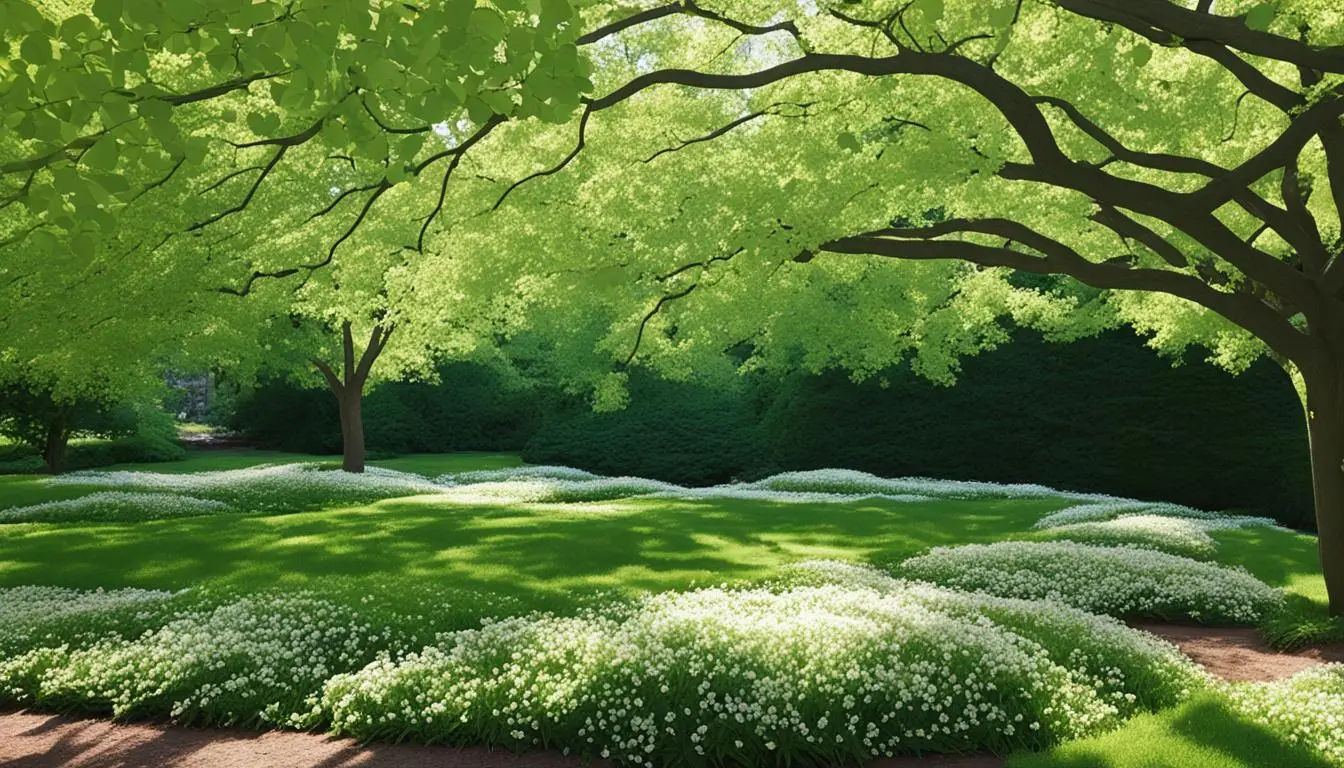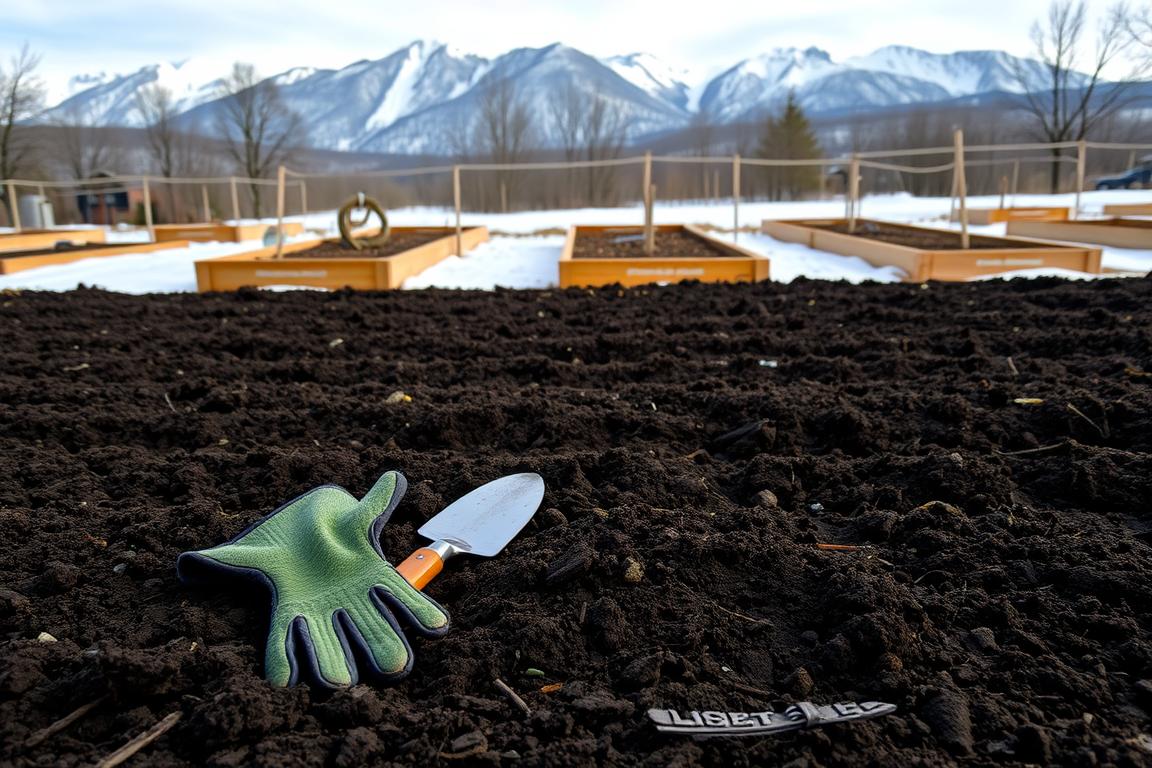Ground covers are perfect for places where regular plants can’t grow well because of shade. They act as a natural cover, saving water and stopping unwanted weeds. Plus, they make the area look more appealing and help animals.
Key Takeaways
- Ground covers are low-maintenance, drought-resistant, and ideal for shaded areas where other plants may not thrive.
- Evergreen ground covers provide year-round coverage and visual interest in shaded landscapes.
- Flowering ground covers add seasonal bursts of color to shady garden spaces.
- Native ground covers are well-suited for shaded areas and offer ecological benefits.
- Ground covers can help control erosion, suppress weeds, and conserve soil moisture in shaded environments.
Evergreen Ground Covers for Shade
Evergreen ground covers are great for shaded spots. They stay green all year, making the area look nice. They are tough, grow close to the ground, and can handle less light. This creates a thick covering that stops weeds and keeps the ground moist.
Waldsteinia ternata (Barren Strawberry)
Barren strawberry is a favorite for dark areas. It stays green and spreads slowly. It does well even in full shade and adds bright yellow flowers in spring. This color brings life to shadowed places.
Leptinella squalida 'Platt's Black'
Leptinella squalida ‘Platt’s Black’ is another good choice for the shade. It has dark leaves and looks like a fern. It doesn’t need much care, can go without water for a bit, and fits perfectly in natural gardens with lots of trees.
Saxifraga Varieties
The Saxifraga group has many types perfect for the shade, like strawberry begonia. They grow close and have pretty leaves and tiny flowers. They fill spaces up like a mat, making the dark corners of your garden look beautiful.
Ground Covers for Shade: Lush Greenery in Shaded Areas
There are many shade-loving ground covers perfect for shady spots in your garden. Veronica umbrosa ‘Georgia Blue’ is great. It has pretty blue flowers and stays evergreen in part shade. Umbilicus oppositifolium ‘Jim’s Pride’ is also good. It has succulent-like leaves and small yellow flowers.
Oxalis Species
The Oxalis genus has plants that do well in the shade. They’re good ground cover alternatives to grass in woodlands. These plants look like clover and come in pink, white, or yellow flowers. They make shade gardens look whimsical.
Flowering Ground Covers for Shady Areas
Flowering ground covers brighten up areas that get some or lots of shade with bursts of color. Geranium x cantabrigiense is a favorite choice. It’s a low-growing plant that spreads and has pretty pink-purple flowers. These flowers last quite a while. Anemone nemorosa ‘Vestal’ is another excellent option. It’s a delicate, white flower that covers the ground in the early spring.
Cyclamen hederifolium is also worth considering. This plant surprises with pink or white flowers when fall comes. Its evergreen leaves are marbled. These ground covers make shady spots beautiful. They’re great for wildlife too. Pollinators love them because they offer food and shelter.
| Flowering Ground Cover | Sunlight Needs | Bloom Time | Mature Size |
|---|---|---|---|
| Geranium x cantabrigiense | Partial to full shade | Spring to summer | 6-12 inches tall, 12-24 inches wide |
| Anemone nemorosa ‘Vestal’ | Partial to full shade | Early spring | 4-6 inches tall, 12-18 inches wide |
| Cyclamen hederifolium | Partial to full shade | Fall | 4-6 inches tall, 12-18 inches wide |

Native Ground Covers for Shade
Native ground covers are great for shady spots, offering benefits to nature and lasting beauty. The Vancouveria group has many types, like V. chrysantha and V. planipetala. These plants have fine yellow flowers on thin stalks.
Galium odoratum (Sweet Woodruff)
Sweet woodruff, or Galium odoratum, is a favorite for the shade. It forms a scented green carpet and blooms with tiny white flowers in spring. This plant is perfect for filling out wooded areas, attracting helpful bees and butterflies.
Geranium macrorrhizum
Bigroot geranium, or Geranium macrorrhizum, is a strong candidate for shady spots. It spreads a thick, scented mat and displays pink or white flowers by spring’s end. It’s ideal for stabilizing soil and keeping weeds in check in shady gardens.

(empty)
In areas with little rain, drought-resistant plants are a good choice for shady spots. They don’t need much water but still look green and beautiful. Some great options for shade are sedum, creeping thyme, and periwinkle.
Sedum plants create thick, colorful mats with their water-storing leaves. Even in droughts, they stay bright. Creeping thyme, like Thymus serpyllum, smells great and stays low. It does well in spots with some shade and infrequent water. Periwinkle (Vinca minor) is a vining plant that loves the shade. Its shiny leaves stay green all year.
These plants save water and keep the soil from washing away. They also stop weeds and give your garden color all year. They are a great choice for an easy-to-care-for garden.
(empty)
Gardeners can fill shady spots with shade-loving ground covers that are tough and beautiful. They help stop soil from washing away and keep weeds down. These plants add interesting textures and colors to your garden, making it look full and vibrant.
Galium odoratum, or sweet woodruff, stands out. It forms a soft, green mass that smells good when you walk on it. It has pretty white flowers and grows well in shady areas under trees.
Geranium macrorrhizum is another great pick. It stays low to the ground, smells nice, and its leaves change color in the fall. It grows flowers and can live in sunny or shadowy spots.
Leptinella squalida ‘Platt’s Black’ is perfect if you want something easy and water-wise. It looks like ferns and loves the shade. Once it’s settled in, it hardly needs any attention.
Conclusion
Ground covers are a great pick for shaded parts in your garden. They offer beautiful, easy-to-care-for greenery. This is especially helpful where many traditional plants can’t thrive. Ground covers act like a natural blanket, keeping the soil moist and blocking out weeds. They also bring a vibrant touch with their different leaf shapes and colors.
You can choose from many types of ground covers. There are those that stay green all year, some that bloom, and others suited to your area’s natural habitat. These plants turn shady spots into lively, easy-to-look-after spaces. They fight soil washout and create a look like a wooded area, full of life. In a shade garden, they are a must-have for their many advantages.
Using a mix of ground covers improves how your garden looks and helps the environment. You’ll have a rich green carpet in shady spots. These plants can survive and even thrive in places that might be tough for other plants. So, they not only add beauty but also are great for the earth.
FAQ
What are the key benefits of ground covers for shaded areas?
Ground covers are like live mulch. They save water and stop weeds. They also make shaded spots look nicer and help out wildlife.
What are some examples of evergreen ground covers for shade?
Waldsteinia ternata is a great choice. It’s an evergreen that grows low and can handle full shade. Leptinella squalida ‘Platt’s Black’ does well with its dark, fern-like leaves in part to full shade.
What are some shade-loving ground covers that bring lush, vibrant greenery?
Veronica umbrosa ‘Georgia Blue’ is perfect. It has bright blue flowers and stays green most of the time. For a different look, try Umbilicus oppositifolium ‘Jim’s Pride’. It has succulent leaves and yellow flowers that hang down.
What are some examples of flowering ground covers for shaded areas?
Geranium x cantabrigiense is a top pick. It has lovely purple-pink flowers that last a long time. Anemone nemorosa ‘Vestal’ is also great. It covers the ground with pretty white flowers in early spring.
What are some native ground cover options for shaded areas?
Vancouveria species are native ground covers for the shade. V. chrysantha and V. planipetala have yellow flowers on thin stems. Sweet woodruff and Geranium macrorrhizum are other good native choices for the shade.






